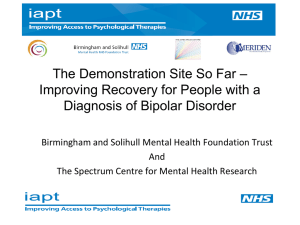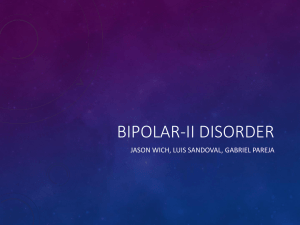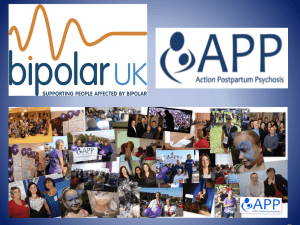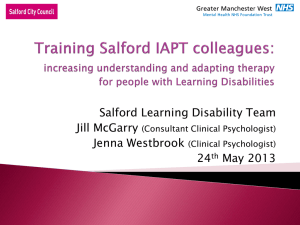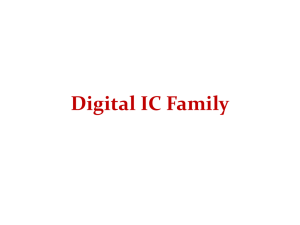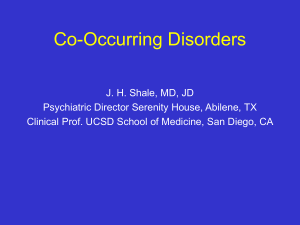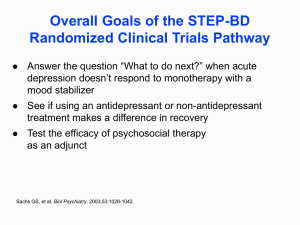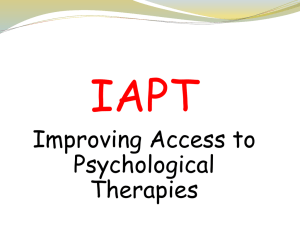National Initiatives in the Development and Delivery of
advertisement
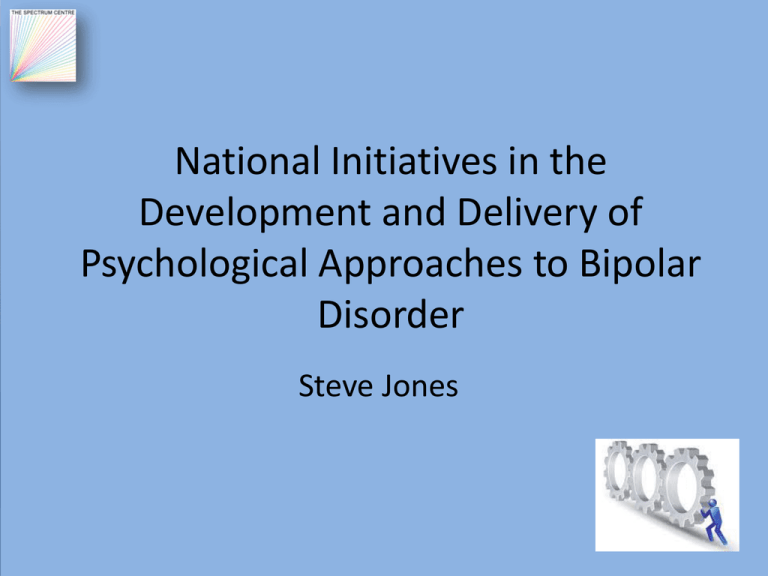
National Initiatives in the Development and Delivery of Psychological Approaches to Bipolar Disorder Steve Jones Introductions • Spectrum Centre for mental health research • www.spectrumcentre.org Overview • • • • • • • What psychological approaches are there out there? What is the mechanism for getting these into practice? Shortfall between aspiration and reality IPT SMI programme Core competencies programme Hopes for the future NB. There are probably new developments I have not heard of yet – if I miss anything please get in touch! Factors associated with course and outcome • Increasing evidence for the importance of psychosocial factors in bipolar disorder • BPS report highlights psychological factors in understanding and treating bipolar disorder (Jones et al. 2010) Psychosocial Factors in Bipolar • Life events – both positive and negative associated with triggering episodes • Cognitive styles – – Dysfunctional beliefs – Positive self appraisal – Depression avoidance – Johnson & Fingerhut, 2006 – Mansell & Scott, 2006 – Jones, 2006 – Bentall et al, 2006 Psychosocial Factors in Bipolar • Activity and sleep patterns • Approach to early warning signs • Family environment and communication styles • • Jones, 2006 • Lam & Wong, 2006 Morris & Miklowitz, 2006 Psychosocial Factors in Bipolar • All of these factors are potentially amendable to psychological interventions Where do people sit within services? • Key feature of bipolar is its fluctuating course • Care needs fluctuate similarly • Many people with bipolar often not in mental health services • Many receive care in primary care or from third sector Diagnostic Issues • Average 10 years from first contact with services to bipolar diagnosis • Evidence for misdiagnosis even for those within mental health services • Many people have bipolar features without meeting full BD criteria • Bipolar relevant therapies are potentially relevant to around 5% of population! Hirschfeld et al., 2000 Perlis, et al., 2005 Smith et al., 2011 Psychosocial Interventions • Aims – traditionally symptom focused but becoming more recovery orientated • Meta-analysis of psychological therapies as adjunct to medication (Scott et al 2007) – significant reduction in relapse rates (of about 40%) compared to standard treatment alone. – most effective in preventing relapses in people who were euthymic when recruited into the treatment trial – less effective in those with a high number of previous episodes (>12) NB – Scott CBT trial 2006– no benefit Psychological Interventions are effective (for some people) Established interventions (there are more) – Cognitive Behaviour Therapy • Lam et al., 2003/2005 • Scott, 2006 • Ball, 2006 – Interpersonal and social rhythm therapy • Frank et al.,2005, 2008 – Family focussed therapy • Miklowitz et al., 2003 – Group psychoeducation • Colom et al., 2003, 2005,2009 • Castle 2010 – Enhanced relapse prevention • Lobban et al., 2010 – Mindfulness-based Cognitive Therapy (MBCT) • Williams et al (2008) Access issues • High level of demand for psychological services in bipolar (MDF etc) • Access restricted by lack of training, poor detection, lack of specialist knowledge and stigma about use of services • Many people not in MH services so even less likely to access bipolar specific help Risk of Wrong Treatment • Inappropriate treatments can: – trigger mania – be ineffective and increase resistance to more appropriate care – trigger severe anxiety problems – fail to recognise common comorbidity issues – fail to recognise risk factors including risk taking and suicidality • Surveys at IoP and Manchester indicate access rates to CBT for psychosis around 7-8%. Probably lower for BD as services less configured for them. Wrong Treatments • Pharmacological interventions focussed solely on depression • Psychosocial approaches focussed only on depressive episodes or psychotic experiences • EWS interventions done badly NICE Guidelines 2006 • National Institute for Clinical Excellence 2006 guideline “Bipolar disorder: The management of bipolar disorder in adults, children and adolescents, in primary and secondary care” Recommends: • Structured psychological therapy for relapse prevention and enhanced coping • Delivered by clinician trained in CBT or similar • Although there are strengths to NICE it reflects current focus on medical over psychological perspectives – i.e. 159 pages on medication – 25 pages on psychological support • Important because – it affects the messages people receive on diagnosis – It affects the ways in which care is delivered – It affects the types of care that are prioritised and offered NICE Guideline Rewrite • Bipolar guidelines currently being updated • Substantial increase in volume of psychosocial intervention trials since last guideline • Level of evidence assigned is a potential issue (psychological trials less common than drug trials as therapy costs much higher) • Reports in 2014 Key challenges with bipolar clients • High needs for autonomy • Treatment ambivalence – many value their bipolar experience (not just mania) • Varying mood states from depression through euthymia to mania • High levels of comorbidity including anxiety, substance use and self harm/suicidality Key challenges • CBT informed psychological approaches ideally placed to address these challenges • But requires clinicians with appropriate training, support and supervision • Range of needs of clients means that good psychological care can range from self management to intensive psychological therapy What was happening before IAPT SMI? • Informal survey of IAPT colleagues and of BABCP Bipolar SIG nationally • “CMHT practitioners highlighted that psychological therapy specific for clients with Bi-Polar are not routinely offered in secondary care” • “IAPT workers could be seen as useful to bridge the gap between primary/secondary care” • “What should I do with people referred to IAPT for depression treatment who have bipolar disorder? I am not trained in BD interventions so do I just treat as unipolar?” What was happening before IAPT SMI? • Modern matron delivering inpatient care to individuals recovering from mania (adapted EWS approach) (Tees) • Pilot care pathway BD and psychotic symptoms (East Anglia) • Psychology services delivering 10 session group psychoeducation intervention to recent diagnosis clients (Swindon) • CBT in primary care for bipolar clients currently stable ? Training? Supervision? Based on own reading? (Preston) Service developments • Some great individual initiatives • Not a consistent picture nationally • Types of intervention not necessarily based on current evidence for what is effective • Lack of infrastructure, training, support and supervision IAPT SMI • Process began in Nov 2011 with national stakeholder event • Since then work has been driven forward by an expert advisory group and a series of task and finish groups • In parallel a separate expert group has developed core competencies for SMI therapies IAPT SMI • Demonstration site programme is intended to provide model for good practice and for future development • Our demonstration site is evaluating current good practice, exploring ways of improving access and considering the incorporation of new therapy initiatives Core Competencies • G • roup New Therapy Developments to Inform IAPT SMI • At Spectrum current RCTs include • Group psychoeducation delivered by service users and clinicians (Lobban) • CBT for anxiety in bipolar disorder (Jones) • CBT for alcohol use (Barrowclough & Jones) • Recovery informed CBT for early bipolar disorder (Jones) New Therapy Developments • Self management approaches • Self management intervention for relatives (psychosis including BD: Lobban) • Web psychoeducation intervention for adults with BD • Web intervention to relapse in adults with BD • Web intervention for bipolar parents Other Developments (Not exhaustive) • Manchester – Mansell – TEAMS approach based on Mansell’s appraisal model (RCT) • Exeter – Wright – Physical activity and bipolar disorder • Glasgow/Edinburgh – Gumley, Schwannuer et al. – Integrated psychological therapy approach (RCT) • Cambridge – Holmes – Development of imagery related approaches to BD • Oxford – Williams & Miklowitz – Mindfulness for BD Challenges • Funding funding funding … • Big challenge is to use the outcomes of demonstration sites to extend support for programme • This would include setting up appropriate training in line with competencies • No chance of the same level of funding for IAPT 1 • Changes in line with IAPT SMI will be ‘within existing resources’ Thanks for your attention • Contact for further information: s.jones7@lancaster.ac.uk www.spectrumcentre.org

